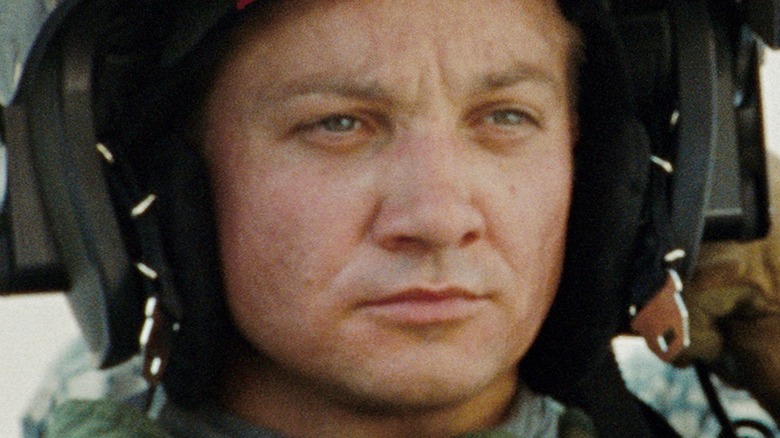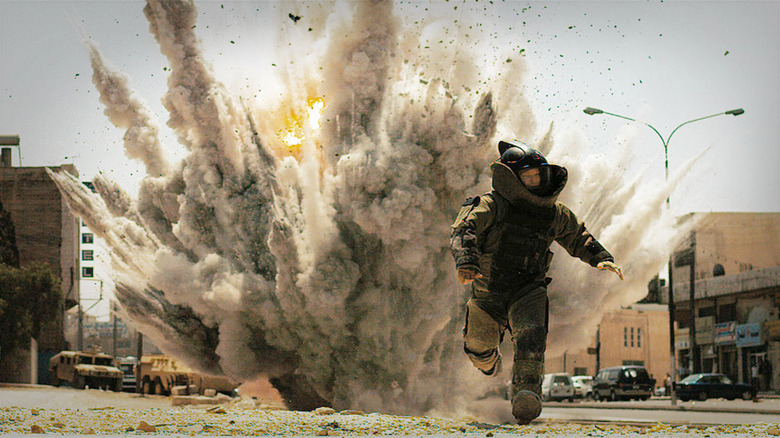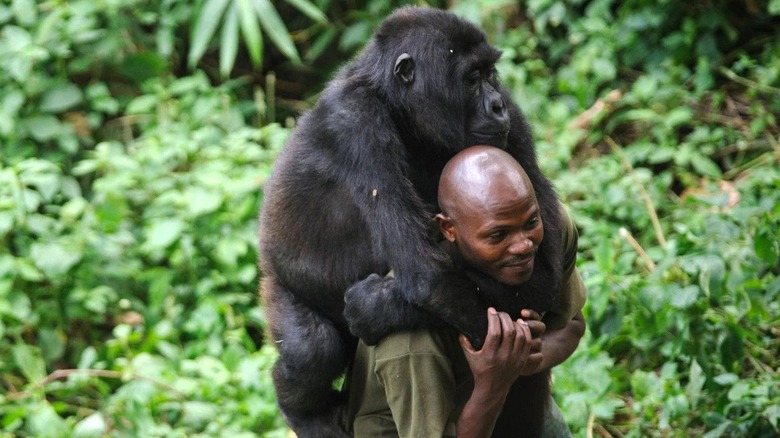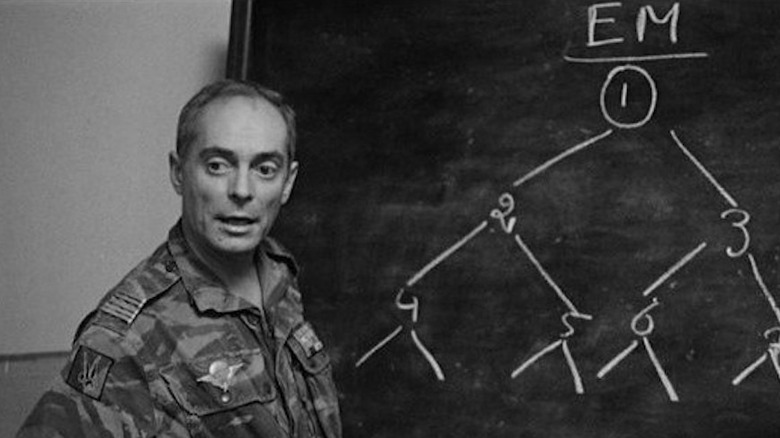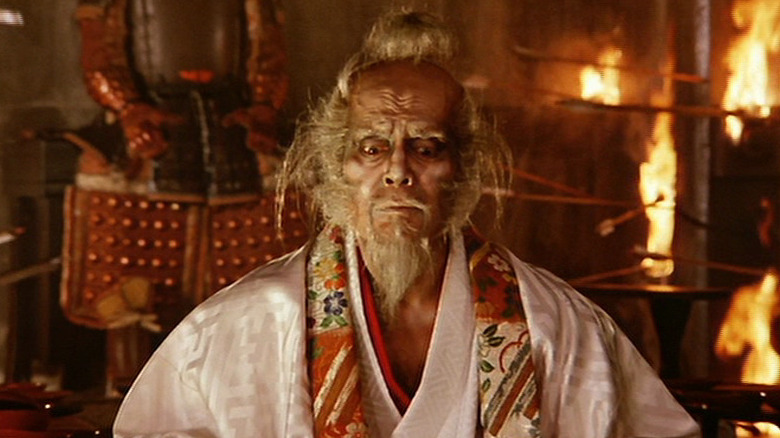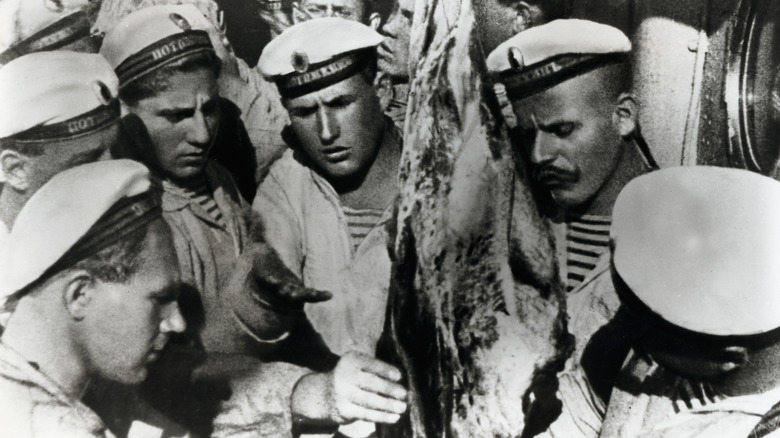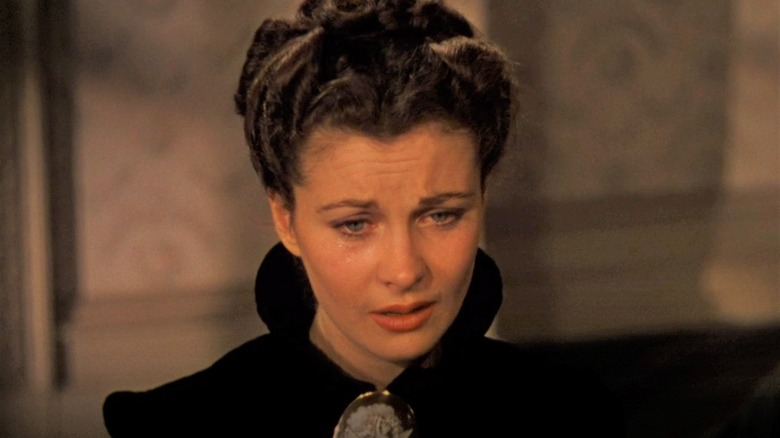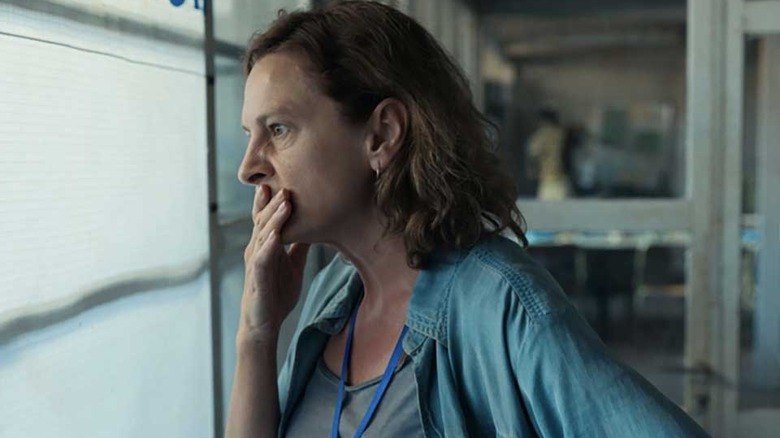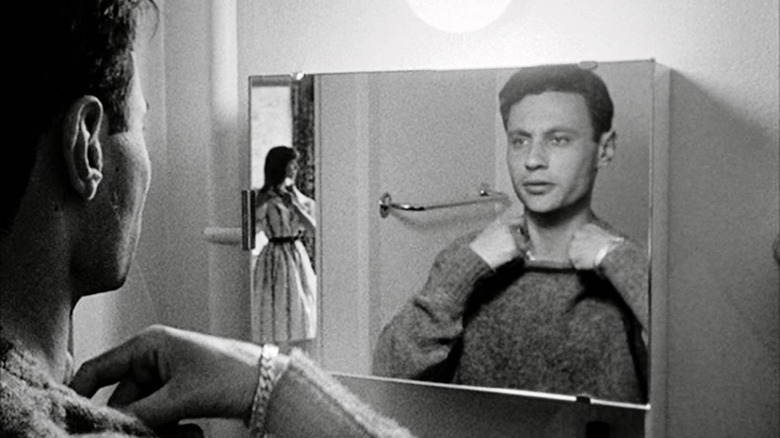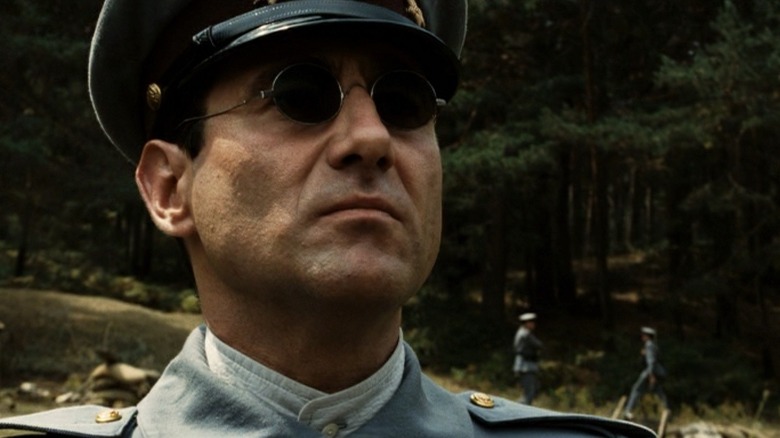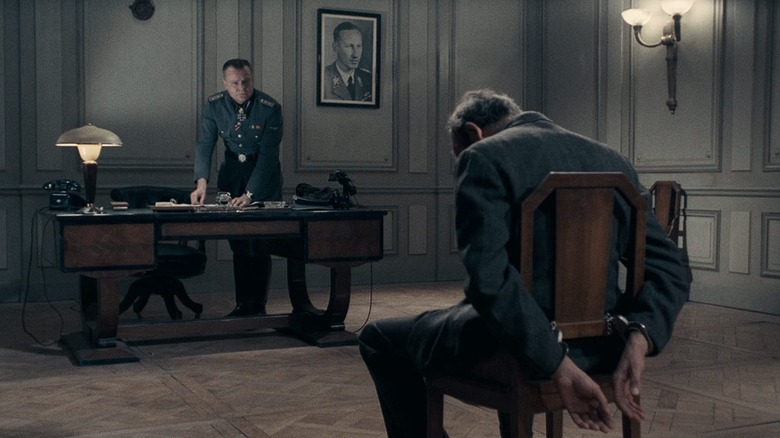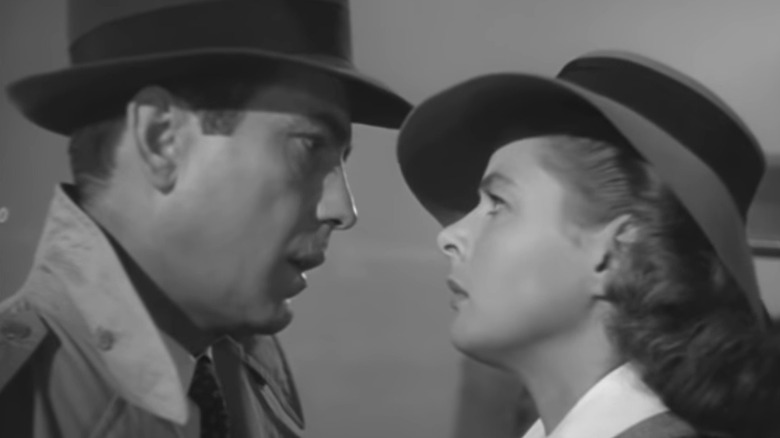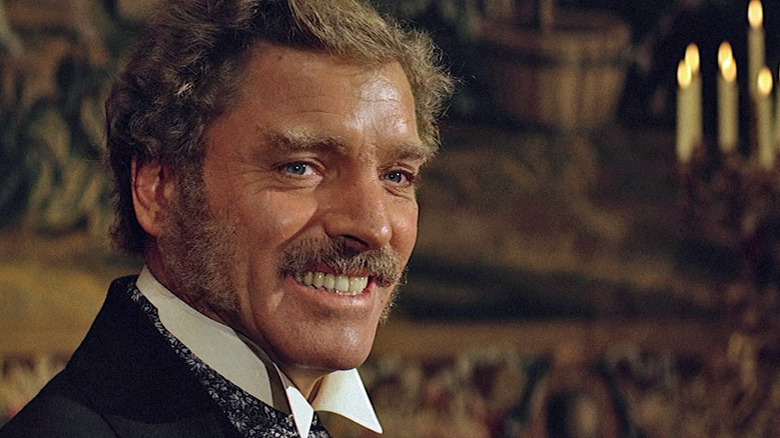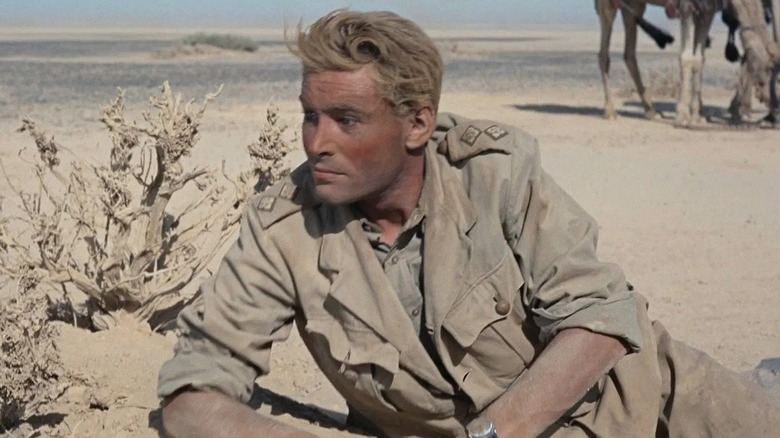There Are Only 13 Near-Perfect War Movies According To Metacritic
"War movies" sound like they would all have a lot in common, but the top-rated ones on Metacritic prove the genre is wider and deeper than you might think. Not all the movies are even about soldiers. Some of the best films on this list take place on the edges of war, looking at what happens to spies or even displaced civilians. Some tackle war directly, making it their primary subject, and some only use it as a catalyst to look at people in a crisis. But all these films hit hard and stay with us.
Whether we like it or not, war is a major part of our history and our present. So it's no surprise that filmmakers and audiences alike have been drawn to the topic again and again. We want to see and understand. We want to empathize — sometimes with horror, sometimes with honor, and sometimes only with exhaustion. These are the movies that, according to Metacritic, evoke those feelings best.
The Hurt Locker
Arguably the best contemporary war film around, 2008's "The Hurt Locker" is a grounded and viscerally effective look at an American bomb squad expert (Jeremy Renner) in the Iraq War. The movie bypasses any big-scale questions about the purpose or political background of the conflict and instead gets at why someone might leave a safe life to go fight it. And the answer it gives is unusual and sentiment-free: Renner's Staff Sergeant William James is an adrenaline junkie. The high-octane, pulse-pounding work he does is dangerous, but it gives him a sense of purpose and satisfaction that civilian life — even fatherhood — can't.
This demythologizing take makes the film stand out. War movies are usually pessimistic about the value of war and its devastating toll. "The Hurt Locker" takes a different angle, and it pays off. The movie won wide acclaim, including an Oscar for Best Picture. Writing for The New York Times, A.O. Scott nailed it, saying, "The movie is a viscerally exciting, adrenaline-soaked tour de force of suspense and surprise, full of explosions and hectic scenes of combat, but it blows a hole in the condescending assumption that such effects are just empty spectacle or mindless noise." Couple that with its 95 Metascore, and it sounds like a must-see to us.
Virunga
"Virunga" has a Metascore of 95 ... but it's a film you might not have heard of. However, once you've seen it, you can't forget it. Nominated for an Academy Award for Best Documentary, the film takes an unusual angle on the far-reaching effects of war: What happens to the animals? Specifically, with all the conflict in and around the Democratic Republic of the Congo — with all the destruction, poaching, and exploitation — what happens to Virunga National Park and its mountain gorillas?
You can guess that the answer is "nothing good," but as devastating as "Virunga" can be, it also shows the people passionately working to protect the natural beauty and wildlife. The Wrap's Steve Pond says, "The result is gorgeous and wrenching, the indelible chronicle of [an] impossible but essential fight." It's as riveting as it is important, too, so while watching it might be heartbreaking, it's not a hardship. As Variety notes, it comes "with enough action, pathos, suspense, venal villains, stalwart heroes and endangered gorillas for a dozen fiction films," making it a "rousing, must-see work."
The Battle of Algiers
"The Battle of Algiers" is one of the finest films ever made about the on-the-ground process of guerilla warfare. If you want to know how it works, this is the movie you need to see. Its authenticity and lack of sentiment mean it's aged very well over the years.
In 2003, it was even screened in the Pentagon to help educate military officers about what they would see on the ground in Iraq ... and what risks, moral and practical, they would take if they "[won] a battle against terrorism and [lost] the war of ideas." It's easy to concentrate on the Algerian insurgents, rising up against the French colonizers via terrorist cells and the charismatic leadership of Ali La Pointe (Brahim Haggiag), but the French side of things is equally worth examining. It is, as the Pentagon pointed out, a case study in what happens when you apply too much brutality. France's plan "succeeds tactically but fails strategically."
Even outside of its usefulness, "The Battle of Algiers" remains vital. With its 96 Metascore, it's a riveting, suspenseful, down-and-dirty look at what espionage and warfare look like under desperate but paradoxically normal circumstances. Bombs are going off, but people still sit down at cafés. It's the start of having war without battlefields, and seeing it in action is irresistibly compelling.
Ran
Akira Kurosawa made a ton of incredibly engrossing movies, and "Ran" is one of his best. A loose reimagining of Shakespeare's "King Lear" in feudal Japan, the movie follows the warlord Hidetora (Tatsuya Nakadai) who decides to yield power to his three grown sons. It is, of course, a mistake, but when one son, Saburo (Daisuke Ryu), bluntly points this out, his father exiles him. Left with only the sons who crave power and will do anything to get it, Hidetora's life begins to unravel. So does the political situation — and soon, there's all-out war.
"Ran" got a 96 Metascore and rave reviews. Bob Graham with The San Francisco Chronicle said the movie was "as close to perfect as filmmaking gets," adding, "List any element — from concept through cinematography, battle action, editing, acting, sound, music, costumes or whatever, right down to makeup — and Kurosawa's commitment is total. 'Ran' is proof that the spirit can be captured on film. Kurosawa's was."
Kurosawa and Shakespeare just belong together, with him also putting together a stunning take on "Macbeth" with "Throne of Blood." One master of drama and spectacle recognizes another.
Battleship Potemkin
Movies are a universal language, and conflict seen from the ground is usually the same all over, no matter what the fight is for or what side you're on. It's no surprise, then, that the silent "Battleship Potemkin," designed as Soviet propaganda, is effective no matter who's watching it or what investment — if any — they have in the Russo-Japanese war that exists in the movie's background. After all, it's about a more universal struggle than that — the one between the rank-and-file sailors and the higher-ups who ignore them, abuse them, and feed them rotten meat.
One of the best mutiny movies ever made (and boasting a 97 Metascore), "Battleship Potemkin" has found admirers across all cultures — numerous American directors such as Orson Welles and Billy Wilder called it an all-time favorite. In particular, it has a gift for choosing powerful, striking images. As Empire says, "The plate smashing, the fog scene, the Odessa steps massacre, and the roaring lion are among the most famous images ever committed to celluloid. ... If you only ever see one silent film, this is the one it should be. A masterpiece." Its simplicity makes it effective propaganda, giving the movie a moral clarity and the kind of intensity you only get from strongly held beliefs. You can argue with it, but while you're watching it, you won't want to.
Gone with the Wind
"Gone with the Wind" is one of the most divisive movies of all time.
With its 97 Metascore, the 1939 Civil War epic features gorgeous Technicolor visuals, extraordinary acting, a daringly unlikable but charismatic and female lead, one of cinema's most iconic love stories, and enough story and spectacle to make its four-hour runtime fly by. Its characters are larger than life, and their story is almost irresistibly compelling. And certain quotes — "Frankly, my dear, I don't give a damn" — are rightfully iconic.
But the film is also undeniably grounded in racism and Confederate nostalgia. The original novel embodies those ideas even more. Director David O. Selznick had to tweak scenes to avoid praising the Ku Klux Klan and representing it as a necessary way of protecting white women from Black men, as the book does. Even with the most offensive aspects of the novel edited out, the movie remains a paean to the antebellum South, describing it right from the opening as a "pretty world [where] gallantry took its last bow." And while the film led to Hattie McDaniel being the first Black woman to win an Oscar, it also employed plenty of stereotypes in dealing with its handful of Black characters.
There's no way to easily settle the complex legacy of "Gone with the Wind" and its place in cinematic history. But for better or worse, it's a significant part of American culture and of an ongoing conversation.
Quo Vadis, Aida?
The most recent film on this list, "Quo Vadis, Aida?" ("Where Are You Going, Aida?") is a 2020 movie that's already leaving its mark on history. This Bosnian film follows the life of Aida (Jasna Đuričić), a UN translator whose life is completely upended and shattered by invasion, war, and genocide. Most war movies look at conflict from the perspective of someone involved in the combat itself. "Quo Vadis, Aida?" looks at what it's like to be a civilian helplessly swept up in the tide. Aida is smart, skilled, and resourceful — but does any of that matter? Will any of it help her and her family stay alive?
A brutal, unsparing look at both war and inefficient, unhelpful organizations of peace, "Quo Vadis, Aida?" isn't a movie that you can watch lightly. At times, it probably won't even feel like a movie you can survive. As IndieWire puts it, the movie "lays bare the deeply human toll of violence and war. ... Beyond bullet holes and body counts, unimaginable atrocities give way to everyday indignities, thousands of tiny cuts overlaid on the unbearable weight of memory."
This is both a hard look at a specific historical tragedy that's often ignored and an unforgettable study of what could be happening on the margins of every war movie. No wonder it earned a 97 on Metacritic.
Le Petit Soldat
"Le Petit Soldat" ("The Little Soldier") is French filmmaker Jean-Luc Godard's look at the Algerian Revolution. And — this is typical for Godard — you can't find any moral clarity here, only existentialism, confusion, and a certain wry humor.
The film is about a man, Bruno Forestier (Michel Subor), who's made an effort to avoid the war. It's counterproductive, as the war finds him anyway. (The movie makes it so clear that the war is a dangerous, demoralizing mess — one where France doesn't have the moral high ground or the assurance of victory — that the French government banned it.) While Bruno gets reluctantly swept up in espionage, murder plots, and dirty dealings, he's no James Bond. This is a film where, as critic Nicholas Elliott puts it, the "protagonist yearns for heroism more than he embodies it. It isn't pretty, but it feels like the truth."
The movie earned a 97 Metascore, and Roger Ebert gave the film four stars, saying it shows "the intellectual and moral confusion that good men have when they confront senseless events." That's a theme that, sadly, always ages well. Especially when the truth is that, for Bruno, there's no good answer and no good way out of his problem. He can't — and shouldn't — run away, but there's no good or safe place to make a stand. Sometimes the only choices are bad ones.
Pan's Labyrinth
"Pan's Labyrinth" has a lot of truly horrifying moments. When you're looking at the gaunt, monstrous Pale Man with his eyes in the palms of his hands or a grotesque giant toad that vomits up its own stomach, you have good reason to admire — and fear — director Guillermo del Toro's imagination. But some of the most ruthlessly terrifying parts of "Pan's Labyrinth" are the ones that could've been pulled straight out of history. There are few movie scenes as brutal as Captain Vidal (Sergi López) beating a man's face in with a bottle.
That's fascism in action, and it's the reason the rebels in "Pan's Labyrinth" risk their safety and their very lives to oppose Vidal and others like him, who held violent sway in Francisco Franco's Spain. Del Toro doesn't shy away from showing the dangers of struggling against the regime; there's torture here where death comes as a merciful relief. All this real-world horror is the necessary, grim counterpart to young Ofelia's (Ivana Baquero) journey into a dark fairy tale. Both halves of the movie work together perfectly.
That juxtaposition helped "Pan's Labyrinth" earn its 98 Metascore and become a breakout hit. Empire called it del Toro's "masterpiece to date, establishing him among the best filmmakers currently working at the top of their game." It may still be his best film, even now. There are scenes and images here that will stay with you forever — whether you want them to or not.
Army of Shadows
There are so many great World War II movies that it's hard to ever pick a favorite, but we have a particular fondness for films that take unusual approaches. The 1969 French film "Army of Shadows" — with its 99 Metascore — falls into that category. Dark and deftly made, "Army of Shadows" follows a group of French Resistance fighters. Their cause is as honorable as they come, but their lives are bleak and desperate. There's an old military saying that war is long periods of boredom punctuated by sheer terror. Well, guerilla espionage and struggle seems to be long periods of uncertainty and anxiety punctuated by agony and brutality. Any sense of hope the characters get inevitably feels short-lived. You watch it knowing which side won, but that knowledge almost doesn't help.
On its original release, the film attracted harsh criticism in its native France, mostly for its portrayal of Charles de Gaulle. But time — and a wider international release — have been kind to it. The New York Times called it "dark as pitch and utterly without compromise" and "bleak and beautiful by turns, that rare work of art that thrills the senses and the mind." It's an existentialist thriller for the ages.
Casablanca
With its Metascore of 100, "Casablanca" tends to get remembered as a romance, but the fact that World War II is pressing in around the edges is key to the movie's plot and its famous bittersweet resolution. The love story between Humphrey Bogart's Rick and Ingrid Bergman's Ilsa has to take a backseat to the global conflict. The film doesn't need battle scenes to evoke the feeling of war. All it needs is the certainty that ordinary people have to be prepared to sacrifice their lives for something bigger than themselves.
With one of cinema's best love stories — the chemistry between Bergman and Bogart has to be seen to be believed — fine storytelling, luminous cinematography, and endless iconic quotes, "Casablanca" is a must-watch that richly deserves its place in movie history, and as Roger Ebert explained, its charms never get old. "Seeing the film over and over again, year after year," he wrote, "I find it never grows over-familiar. It plays like a favorite musical album; the more I know it, the more I like it." Angie Errigo at Empire goes even further, calling it "universally beloved" and noting, "You must remember this: you can't trust anyone who doesn't love 'Casablanca.'"
The Leopard
Early American audiences only got a chopped-up and recolored version of "The Leopard," director Luchino Visconti's study of the passing of an era in Sicily. We can't necessarily blame audiences for misjudging it when they weren't getting the real movie. But luckily, restorations are now widely available. It's time to get this movie the popular attention it deserves.
Boasting a Metascore of 100, the film follows the prince of Salina, Don Fabrizio Corbera (Burt Lancaster), who's living through the last gasp of the Italian aristocracy he embodies so well. Immersed in both politics — the whole plot is shaped by the conflict between Garibaldi's redshirts and the king's army, between revolution and decay — and one man's sense of his own fading place in the world, "The Leopard" shows how we all live in the midst of history.
Over the years, especially after its restoration, "The Leopard" has attracted more and more admiration from those who appreciate its elegant, elegiac luxury. Don't let its length or leisurely pace drive you away. No less an authority than Martin Scorsese counts it as one of his favorite films of all time. In an essay that sums up why "The Leopard" deserved both its Palme d'Or win and its subsequent rediscovery, A.V. Club writer A.A. Dowd says, "Some have come to think of it as cinema's grandest epic, the most beautiful example of large-canvas filmmaking." In the end, it's really a film like no other.
Lawrence of Arabia
If you get the chance to see a revival of David Lean's "Lawrence of Arabia" in theaters, take it. With its 100 Metascore, The film is great under any circumstances, but its staggering desert vistas are especially gorgeous on the big screen. It's a movie made to overwhelm you, and it does it with style.
It also features extraordinary performances from actors like Peter O'Toole, Alec Guinness, and Omar Sharif. (Several of the white actors, like Guinness, are in brownface. While this isn't intended as mockery or a way to play up stereotypes, it can still be uncomfortable. Sharif's presence here helps make up for it at least somewhat.) The film entangles them all in a grand, complex, deeply emotional, and politically cynical epic about war, empire-building, belonging, and loss.
"Lawrence of Arabia" is one of the most acclaimed films of all time, regularly appearing near the top of "best film" lists. It's one of Steven Spielberg's favorite movie and seeing it in high school marked him forever. "I wasn't able to digest it in one sitting. I actually walked out of the theater stunned and speechless. ... It pulverized me," Spielberg once said (via Top 10 Films). It tends to have that effect, but don't mistake its huge impact for a lack of nuance. As Slant Magazine put it, it's "a big film, but never so big that the details get lost."
